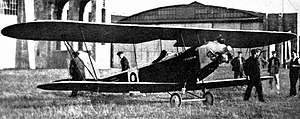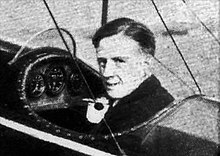Supermarine Sparrow
| Sparrow | |
|---|---|

| |
| Sparrow I at the 1924 Two-Seater Light Aeroplane Competition at Lympne | |
| Role | Two-seat light sports aircraft |
| National origin | United Kingdom |
| Manufacturer | Supermarine Aviation Works |
| Designer | R.J. Mitchell |
| First flight | 11 September 1924 |
| Retired | 1930 |
| Number built | 1 |
The Supermarine Sparrow (later called the Sparrow I) was a British two-seat light biplane designed by R.J. Mitchell and built at Supermarine's works at Woolston, Southampton. It first flew on 11 September 1924. After being rebuilt in 1926 as a parasol monoplane, it was re-designated Sparrow II.
The Sparrow was Supermarine's earliest landplane. It was a wooden two-seat sesquiplane powered by a 35-horsepower (26 kW) Blackburne Thrush. It had foldable wings with different cross sections; to allow the aircraft to take-off and land over short distances, Mitchell gave the wings a high angle of attack. The Sparrow behaved erratically during tests. It was entered for the 1924 Two-Seater Light Aeroplane Competition but suffered engine failure during the competition. A substitute engine failed during the race, forcing the pilot to land at short notice, and the plane was eliminated.
Sparrow II was heavier and slower than its predecessor. It was entered for the 1926 competition at Lympne but, having made a forced landing near Beachy Head, was eliminated. Mitchell went on to use Sparrow II to test new aerofoil designs for the Air Ministry. It was subsequently sold to a flying club and was scrapped in 1933.
Background
[edit]Following the end of World War I, private flying in the UK was progressed slowly. Ex-military aircraft were generally unsuitable, having been designed during the war to suit specific purposes, and aircraft companies considered that little profit could be obtained from aircraft made for private use.[1]
In 1923, the Royal Aero Club organised the first of a series of annual flying competitions at Lympne, Kent, for single-seat aircraft.[1] The following year, Supermarine entered the Sparrow for the Two-Seater Light Aeroplane Competition, which was held in late September and early October 1924. The winner's prize was £2,000 (equivalent to £135,108.57 in 2023)[2] for "the best light plane designed and built in Great Britain, suitable for flying clubs and the private owner".[3]
Design
[edit]The Sparrow was Supermarine's earliest design for a landplane, following the company's change of identity from Pemberton-Billing Ltd in 1916.[4][5]
Designed by R.J. Mitchell, Supermarine's young chief designer, the Sparrow was a wooden two-seat sesquiplane, with wings that were designed to fold. The two wings had different cross sections. The aircraft was powered by a 35-horsepower (26 kW) Blackburne Thrush piston engine, with dual controls. The engine was, however, untried.[3][6]
The fuselage was built of fabric-covered plywood. The propellers were made to match the rotation speed of the engine, which, at 3500 rpm, was unusually high. The aircraft's hull and struts were painted dark blue.[3] Mitchell took the need for the aircraft to handle short take-off and landing runs into his design. He ensured that the wings were given a high angle of attack, providing the fuselage with an upward kink. Both wings were fitted with aerofoils.[6]
Performance
[edit]Sparrow I
[edit]
Sparrow I first flew on 11 September 1924, piloted by Henri Biard.[3] It was refitted with a modified propeller on 27 September.[7] Its behaviour when being tested was erratic. According to Biard, "it was as impudent as its name implied".[8] The Sparrow was demonstrated before its designer, R.J. Mitchell, and other Supermarine directors. The engine failed when the plane was airborne, and the directors raced towards a hole in a hedge that it had crashed through. Biard was found, unscathed. Attempts to restart the engine failed, and the demonstration was called off. The Sparrow then flew back without further trouble.[8]
The Air Ministry assessment described the Sparrow as lacking attention to detail — specifically referring to the inadequate design of the landing gear and the excessive number of external controls. The pilot's view from the cockpit was limited by the position of the upper wing.[6]
The three-cylinder radial engine proved to be extremely unreliable, and the Sparrow was eliminated from the light aircraft trial due to engine failure, when a connecting rod failed. An engine substituted to replace the original machine initially refused to start and then seized, forcing Biard to make an emergency landing.[7]
In the Grosvenor Trophy Race at Lympne on 14 October 1924, it came fourth with a speed of 62.08 mph (99.91 km/h).[7] During the first lap of the race, the Sparrow overtook a Westland biplane and maintained this position until the sixth lap, when it was in turn overtaken by the Bristol Brownie.[9]
The Sparrow was registered as G-EBJP, but it never apparently carried the marking. Photographs of the aeroplane show that it was marked with numbers during the competitions it was entered for.[3]
Sparrow II
[edit]
Re-designated the Sparrow II, the aircraft was rebuilt and re-engined with a 32-horsepower (24 kW) Bristol Cherub III engine. It entered the 1926 competition[note 1] at Lympne as a parasol monoplane.[11] Sparrow II was 130 pounds (59 kg) heavier and 7 miles per hour (11 km/h) slower than its predecessor.[10]
Sparrow II was outclassed but successfully passed the elimination trials. It failed to pass the racing starting line; due to poor weather conditions,[10] it made a forced landing near Beachy Head on 12 September 1926, with Biard noticing that loose rivets were likely to cause the wings to fall off. Sparrow II was thus eliminated from the competition, which was won by the Hawker Cygnet. Sparrow II competed for two other races the following week, but was unplaced in both. The Sparrow's participation in the 1926 trials delayed work being done at the time on the Supermarine Seamew.[11]
Mitchell used Sparrow II to work with the Air Ministry at RAF Worthy Down, fitting the aircraft with his aerofoil designs for other aircraft, and compared the results obtained with those produced using wind tunnel tests.[10][note 2] The aircraft was then sold to the Halton Aero Club.[12] It survived until 1933, when it was scrapped.[10][13]
Variants
[edit]- Sparrow I
- Blackburne Thrush-powered biplane.
- Sparrow II
- Sparrow I modified into a monoplane powered by a Bristol Cherub III piston engine.
Specifications (Sparrow I)
[edit]

Data from British Civil Aircraft 1919–1972.[13]
General characteristics
- Crew: 1
- Length: 22 ft 8 in (6.91 m)
- Wingspan: 33 ft 4 in (10.16 m)
- Height: 7 ft 5 in (2.26 m) [14]
- Wing area: 256 sq ft (23.8 m2) [14]
- Airfoil: root: NACA; tip: NACA[15]
- Empty weight: 215 lb (98 kg)
- Gross weight: 390 lb (177 kg)
- Powerplant: 1 × Blackburne Thrush 3-cylinder air-cooled radial piston engine, 35 hp (26 kW)
- Propellers: 2-bladed fixed-pitch propeller
Performance
- Maximum speed: 116 mph (187 km/h, 101 kn)
- Service ceiling: 3,350 ft (1,020 m)
See also
[edit]Aircraft of comparable role, configuration, and era
Notes
[edit]References
[edit]- ^ a b Pegram 2016, p. 66.
- ^ United Kingdom Gross Domestic Product deflator figures follow the MeasuringWorth "consistent series" supplied in Thomas, Ryland; Williamson, Samuel H. (2024). "What Was the U.K. GDP Then?". MeasuringWorth. Retrieved 15 July 2024.
- ^ a b c d e Andrews & Morgan 1981, p. 310.
- ^ "Supermarine Sparrow". BAE Systems. Retrieved 6 November 2022.
- ^ Pegram 2016, p. 16.
- ^ a b c Pegram 2016, p. 67.
- ^ a b c Andrews & Morgan 1981, p. 312.
- ^ a b Andrews & Morgan 1981, p. 311.
- ^ "Two-Seater Light Plane Competitions at Lympne". Flight. 9 October 1924. p. 659. ISSN 0015-3710.
- ^ a b c d e f Pegram 2016, p. 68.
- ^ a b Andrews & Morgan 1981, p. 113.
- ^ Andrews & Morgan 1981, pp. 314–315.
- ^ a b Jackson 1988, p. 316.
- ^ a b Andrews & Morgan 1981, p. 315.
- ^ Lednicer, David. "The Incomplete Guide to Airfoil Usage". UIUC Applied Aerodynamics Group. Retrieved 16 April 2019.
Sources
[edit]- Andrews, C. F.; Morgan, Eric B. (1981). Supermarine Aircraft since 1914. London: Putnam. ISBN 978-0-370-10018-0.
- Jackson, A.J. (1988). British Civil Aircraft 1919–1972. Vol. 3. London: Putnam. ISBN 978-0-85177-818-1.
- Pegram, Ralph (2016). Beyond the Spitfire: The Unseen Designs of R.J. Mitchell. Brimscombe: The History Press. ISBN 978-0-7509-6515-6.
Further reading
[edit]- Cull, G.A. (January 1953). "The Supermarine Sparrow". Aero Modeller. RCLibrary. pp. 50–51.
- Shelton, John (2008). Schneider Trophy to Spitfire – The Design Career of R.J. Mitchell (Hardback). Sparkford: Hayes Publishing. ISBN 978-1-84425-530-6.
- "The British Lightplane Competition". Aviation. Vol. 21, no. 18. New York: Gardner. 1 November 1926. pp. 742–754. Retrieved 26 November 2022 – via Internet Archive.
- "The Supermarine "Sparrow" Light Biplane (No. 9): Blackburne Radial Engine". Flight. 25 September 1924. p. 615–617. ISSN 0015-3710 – via Internet Archive.
